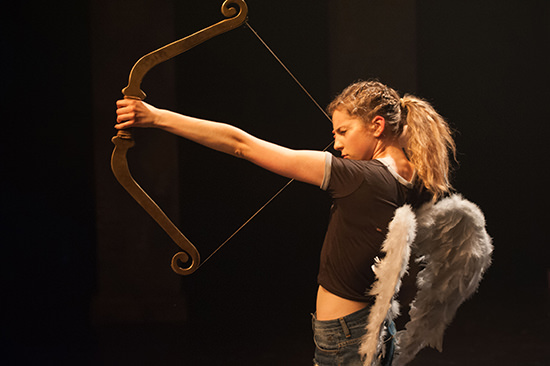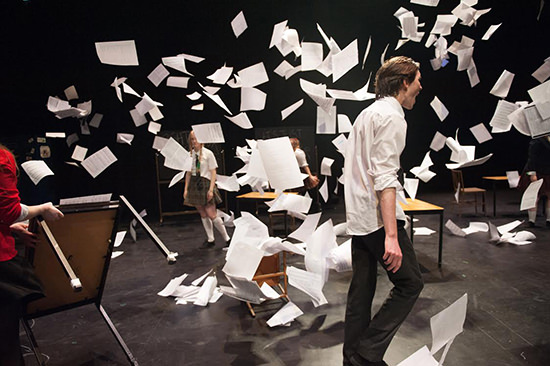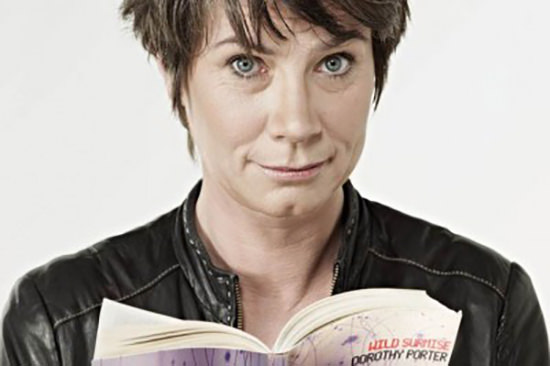Futuring music theatre in the academy
John Bailey: Jane Griffiths, Monash University Centre for Theatre & Performance

Agata Dmochowska, Metamorphoses, music theatre work written and performed by students at the Centre for Theatre & Performance, Monash University
The notion of the New Australian Musical has become something of a unicorn in the Australian performance imagination, and any number of factors—the costs and complexity of mounting a musical, the dearth of appropriate venues, and the relatively small amount of funding, training and support available—make a fully-realised new music theatre work a rare beast indeed. Ten years ago, after its third outing, the Pratt Prize for Musical Theatre ceased to exist as an open competition after judges noted that outstanding entries tended to come from a tiny pool of the same names.
The enthusiasm for new work created locally has only grown, however, and the talent pool has certainly expanded as well. Monash University’s Centre for Theatre and Performance has taken an encouraging new direction in recent years with a substantial rethinking of its music theatre units. Where training institutions such as WAAPA or VCA might focus on voice, acting and other practical elements of music theatre, Monash now includes the history and historiography of music theatre, along with dramaturgy, songwriting and assistance in imagining innovative new ways of approaching the form.
The Centre’s Head of Section—and actor, writer and director—Jane Griffiths calls it a “very holistic course” which is “very, very different from a traditional musical theatre course where it’s more about learning performance skills.”
This new approach has won praise from high places: recently Dr Jeanne Pratt announced a $1 million donation to the Centre to bolster its music theatre teaching. The funds will allow the number of units taught to be doubled and, as of next year, a new residency program will see professional music theatre artists putting down roots at Monash.
Similar residencies at the university have already proven highly successful for non-music theatre artists. “So far we have a very good reputation in the independent theatre sector for providing residencies and as much support as we can to companies like Fraught Outfit or THE RABBLE,” says Griffiths. “We feel that we’re part of an ecosystem. We don’t just want to be a university; we want to be contributing to the industry. With music theatre now we can take that one stage further.

Sticks and Stones, music theatre work performed by students at the Centre for Theatre & Performance, Monash University
“We’ll have two year-long residencies for professional artists who are mid-career, established but still wanting to have time to work on their own practice. They basically come and live at Monash for a year, work on their own material but also mentor the students who are creating new work.”
The benefits students will derive from contact with professional music theatre artists are obvious, but for the artists themselves the residencies offer an opportunity to take stock in what can often be an anchorless job hopping from gig to gig.
“We’re hoping that this will appeal to artists who may already have had a busy career but want to take some time out. That’s important. And the collegiate atmosphere. I think lots of practitioners get to a stage in their career where they need to readdress what they’re doing and we have the collegiate atmosphere where you’re allowed to do that.”
Many practising artists don’t necessarily come from academic backgrounds, either. For them, Griffiths says, there might be appeal in “an environment where there’s a vocabulary or methodology or theory which explains your practice and interacts with your practice.”
The Centre’s expanded, holistic approach to the form and its incorporation of pedagogy and practice has been further amplified by its new ties to Monash’s School of Music. In combination this allows students both comprehensive instruction in what the musical has been in the past as well as encouragement to rethink what it could be in the future.
“I think that one of the exciting things that we’ve discovered and that the students are certainly keen to explore is the different range,” says Griffiths. “They don’t all have to be massive musicals like Wicked, great though those are. They’re exploring smaller scales, exploring site-specific musicals, theatre-in-education musicals. There’s potential for what we think of as the musical to really alter quite radically, in the same way our conceptions of traditional theatre have. At the same time we can really enjoy and celebrate tradition. You can’t beat a good Broadway musical and we understand that.”
Of the enhanced music theatre course and its residency program for experienced music theatre professionals, Jane Griffiths says, “I very much hope our program won’t just nurture our students but nurture practitioners.”
A call for expressions of interest in the Centre’s residencies program will be announced shortly.

Dr Jane Griffiths
Associate Professor Jane Griffiths is an active theatre performer and writer and Head of Section of Monash University’s Centre for Theatre and Performance. She will appear in the lead role in the 1999 Pulitzer Prize for Drama winner, Wit, by Margaret Edson, at 45 Downstairs, 1-17 September. Read more about her here.
Monash University, Faculty of Arts, Centre for Theatre and Performance
RealTime issue #134 Aug-Sept 2016






